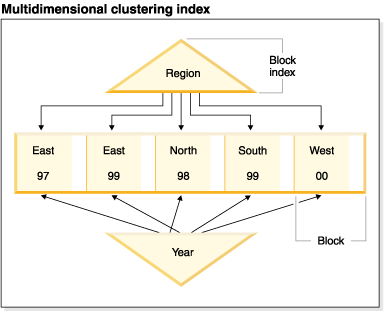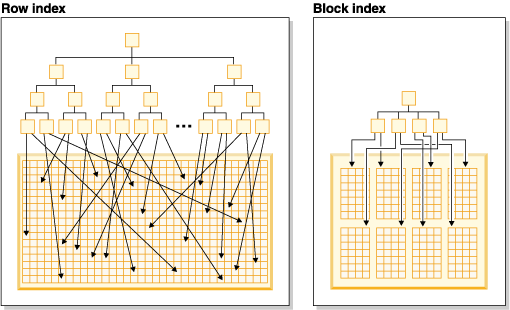This topic shows how records are organized in MDC tables using block indexes.
The MDC table shown in Figure 1 is physically organized such that records having the same "Region" and "Year" values are grouped together into separate blocks, or extents. An extent is a set of contiguous pages on disk, so these groups of records are clustered on physically contiguous data pages. Each table page belongs to exactly one block, and all blocks are of equal size (that is, an equal number of pages). The size of a block is equal to the extent size of the table space, so that block boundaries line up with extent boundaries. In this case, two block indexes are created, one for the "Region" dimension, and another for the "Year" dimension. These block indexes contain pointers only to the blocks in the table. A scan of the "Region" block index for all records having "Region" equal to "East" will find two blocks that qualify. All records, and only those records, having "Region" equal to "East" will be found in these two blocks, and will be clustered on those two sets of contiguous pages or extents. At the same time, and completely independently, a scan of the "Year" index for records between 1999 and 2000 will find three blocks that qualify. A data scan of each of these three blocks will return all records and only those records that are between 1999 and 2000, and will find these records clustered on the sequential pages within each of the blocks.

In addition to these clustering improvements, MDC tables provide the following benefits:
When you create a table, you can specify one or more keys as dimensions along which to cluster the data. Each of these MDC dimensions can consist of one or more columns similar to regular index keys. A dimension block index will be automatically created for each of the dimensions specified, and it will be used by the optimizer to quickly and efficiently access data along each dimension. A composite block index will also automatically be created, containing all columns across all dimensions, and will be used to maintain the clustering of data over insert and update activity. A composite block index will only be created if a single dimension does not already contain all the dimension key columns. The composite block index may also be selected by the optimizer to efficiently access data that satisfies values from a subset, or from all, of the column dimensions.
Block indexes are structurally the same as regular indexes, except that they point to blocks instead of records. Block indexes are smaller than regular indexes by a factor of the block size multiplied by the average number of records on a page. The number of pages in a block is equal to the extent size of the table space, which can range from 2 to 256 pages. The page size can be 4 KB, 8 KB, 16 KB, or 32 KB.

As seen in Figure 2, in a block index there is a single index entry for each block compared to a single entry for each row. As a result, a block index provides a significant reduction in disk usage and significantly faster data access.
In an MDC table, every unique combination of dimension values form a logical cell, which may be physically made up of one or more blocks of pages. The logical cell will only have enough blocks associated with it to store the records having the dimension values of that logical cell. If there are no records in the table having the dimension values of a particular logical cell, no blocks will be allocated for that logical cell. The set of blocks that contain data having a particular dimension key value is called a slice.
Nonpartitioned block index are supported after upgrading the database to DB2 V9.7 Fix Pack 1 or later releases.